Pruning grapes for beginners: tips and rules
Grape - a fairly unpretentious plant. It does not need to be watered every day and track the timing of the blooming of buds and berry ovaries. The only thing necessary for a healthy and rich harvest is timely and high-quality pruning. It must be done not only during the awakening of the bush, but also in autumn and summer. Most importantly, proper care of the vine after a perfect procedure.
Content:
- Spring grape pruning: terms and rules
- Pruning grapes in summer
- Autumn-winter pruning of grapes
- How to properly care for grapes after pruning
- Beginner Tips: What You Need to Know About Pruning Grapes
Spring grape pruning: terms and rules
An important rule of spring removal is that the process cannot be carried out at the time of sap flow. All manipulations with the bush are recommended to be done before the plant wakes up from winter sleep. Otherwise, the vine will lose too much nutrient fluid. This can provoke a low yield level or a complete loss of a fruiting bush.
The first step after the last frost has passed is to inspect all shoots.
The presence or absence of cuttings beaten by frost is revealed. They begin to remove them when the air temperature is normalized to +5 C.
Experts distinguish several stages of deformation of the bush after frost:
- Destroyed up to 75% of the plant - all unnecessary shoots on the second and third branch are cut off.
- More than 3/4 of the bush is damaged - there is a question about the preservation of the grapes. Pruning is done so that the shrub starts growing again.
- After winter, all important buds died - the entire stem is removed, only the 2nd bud is left on each stem.
- Complete loss - the bush will have to be completely removed, but it is worth checking the roots for vitality. It is possible to get vaccinated on intact root system.
After inspecting the plant, you can proceed to the pruning procedure, following some rules:
- The process takes place in mid-April. All damaged, dried and weak shoots are removed. This must be done so that nutrients are directed not at an attempt to restore non-viable areas, but at the development and growth of healthy shoots.
- At the age of two, the plant is cut so that only 2 stems remain, which, in turn, are shortened by 5 eyes.
- It is recommended to carry out the removal with a sharp instrument with a clean coating.
- The cut must be made at a right angle, left even and smooth. The edges should not be torn or flattened.
- A long stalk should not be left (up to a maximum of 12 eyes).
Simple rules for stripping in the spring allow you to grow a healthy bush that can give a large harvest in the fall. The quality of pruning depends not only on the volumes, but also on the taste of the bunches obtained at the exit.
Pruning grapes in summer
Summer cleaning is essential for proper pinching, by rational pinching. Also, the procedure is necessary to reduce the expended nutrients during the formation of a young vine.
In the summer, cutting off unnecessary branches is done to correct the growth of the stems, to balance between bunched branches and empty twigs.
Removing part of the fruiting sprouts serves to enhance the taste and increase the size of the remaining bunches. Otherwise, if you do not cut off the excess shoots with bunches, then the harvest threatens to be with insufficient sweetness and small berries.
List of procedures performed in summer:
- Removing part of the shoot when its active growth ends. This artificially redirects all the nutrients from the empty vines to the stems with berries.
- Pinching of the top growth point in order to provoke the growth of lateral branches.
- Grasshopping - the elimination of the second level twigs for the best saturation of the shoots with bunches.
Cutting off excess stems, dried leaves is necessary for better saturation of ripening bunches with sunlight, as well as for normalizing ventilation between the branches.
Approximate dates of the events:
- The beginning of June - thinning of young stock, obligatory garter of stems with brushes, cleaning of branches by 2-3 eyes to form replacement sprouts.
- End of June - beginning of July - feeding the bush mineral fertilizers, pinching.
- The beginning of August - removal of excess young by 20%, if it has reached 1 meter in height or more.
- Mid-August - thinning of foliage, which prevents the penetration of sunlight to the lower levels of the bush.
Summer cutting off a part - preventive measures for diseases, also contributes to the easy transfer of the growing season. Thus, cutting off a part of the vineyard at the time of active growth is a kind of cleansing from unnecessary, superfluous young growth. The latter do not carry bunches with the harvest, but only extract useful juices from the plant, which could be used to improve the quality of ripe berries.
Autumn-winter pruning of grapes
Autumn activities to remove excess on the vines are carried out until the first days with sub-zero temperatures hit. Some gardeners believe that cutting should be carried out immediately after harvesting, but in this case, the plant often does not have time to stock up on all the nutrients necessary for a favorable wintering. Therefore, the best period for the procedure is mid - late autumn.
If timid snowflakes are flying in the air, and the thermometer shows -3-5 C - such a moment is also not favorable.
At a similar temperature, the juice inside the branches freezes and when cut, the cuttings either break, or there is a crack all over the body. This can provoke the loss of the entire sprout. The main stage is the removal of all brushes and dry cuttings remaining on the branches. In autumn, cut off damaged shoots and sleeves. All fat sprouts on two-year-old wood are removed.
Injured areas may contain settlers pests, which are able to overwinter the branches inside the trunk and in the spring safely begin to eat the remaining shrub, thereby provoking the death of the entire vineyard. Before hiding for the winter, it is recommended to remove the entire upper part of the plant's processes. They begin in the fall after the foliage has completely fallen off, when the grapes begin to fall asleep. The most optimal moment should be chosen - all nutrients have been collected for normal wintering and for the future growth period, but the cold has not yet come.
Approximate dates of the procedures:
- The beginning of September is the cutting of lateral young stepchildren on last year's branches that have grown to 60 cm in height from the ground level. In a 30 cm zone from the ground, fresh cuttings are cut only at the upper point of growth.
- Mid-October - the formation of the fruit link begins. Take 2 strong cuttings, the most elongated in growth. The one located in the lower cavity is cut so that only 3 buds remain (replacement shoot).The sprout that is located above is trimmed to 6 eyes.
- Mid-September - removal of all branches not exceeding 20 cm.
Stepsons who have grown up to 30 cm are cut off by 1 of the total volume. All places of the cut should be prudently treated with garden pitch so that the process of decay and colonization of pests and diseases does not occur. These procedures are planned preparation for wintering and sheltering grapes for crops that are afraid of frost.
How to properly care for grapes after pruning
Care after cutting procedures is reduced to the following activities:
- Carrying out glaze with the calculation of 1 bucket of water per shrub.
- It is imperative to feed the plant with ammonium nitrate, superphosphate, ammonium sulfate, nitroammophos.
- Thorough loosening of the soil (so as not to damage the root system) after abundant watering and feeding is acceptable.
- To avoid frequent deletion weeds, as well as for prolonged soil moisture near the trunk, it is recommended to mulch the soil.
- You should not give up the garter of young branches as they grow. This will serve as a good support for the further preservation of the crop.
It should be remembered that a cut of grapes at any time of active growth can provoke the appearance of pests, diseases or infections of a fungal nature. In order to protect the plant, it is necessary to resort to processing the cuts either with garden varnish, or fungicidal preparations.
If the first signs of damage to the bush with gray rot are noticed, it is recommended to irrigate the vine and leaves with a solution of potassium permanganate, and sprinkle the brushes of berries with a mixture of water and baking soda. In the springtime, it is recommended to cover up all "leaking" wounds with paint, wax, or wire it over. For disinfection, spray with diluted magnesium chlorate solution.
Beginner Tips: What You Need to Know About Pruning Grapes
The main condition for successful circumcision is that a small penny remains, up to a maximum of 0.5-1 cm. Such a measure is required so that the wound does not crack and damage the healthy branch during healing, drying out.
It is best to cut the branches so that the stumps are facing the center of the bush, so the wounds heal faster.
Cutting must be done with a sharp tool (pruner, garden saw or scissors) in one go, without shredding the trunk. Young cuttings should not show any damage. Arrows of fruiting shoots in diameter - no more than 1.2 cm, strong and healthy in appearance. In the fall, all sprouts that bear fruit are removed. They will not give an increase for the next year, they will only pull useful substances onto themselves.
Pruning implies the formation of a vine into a full-fledged fruiting shrub, therefore, in the first year, only 2 strong and healthy shoots are left (1 for a stem, 1 for a replacement). Next year there should be 4 of them left. Do not leave a large number of bunches. The harvest will result in a lot, but it will not be able to compete in sweetness and large volumes. Thus, timely and correct removal will not only allow the formation of a small shrub that will not grow in vain throughout the territory, but will produce decent ripe berries.
More information can be found in the video:



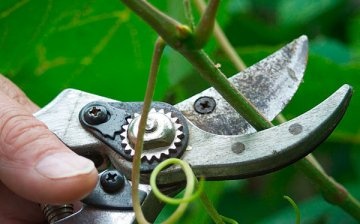
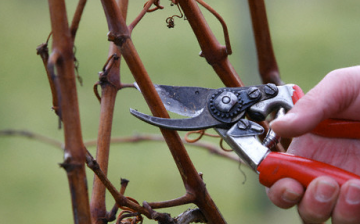

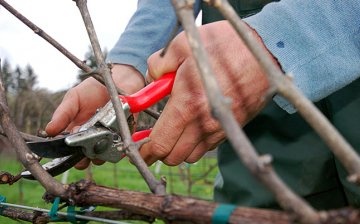
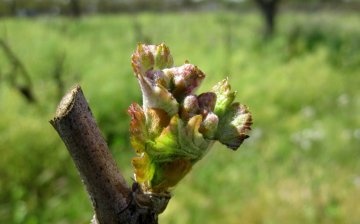
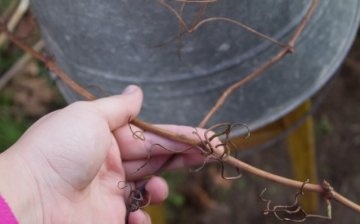






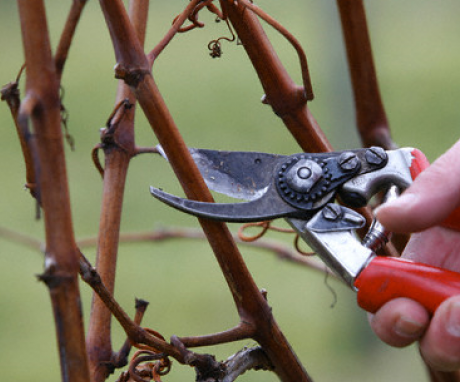
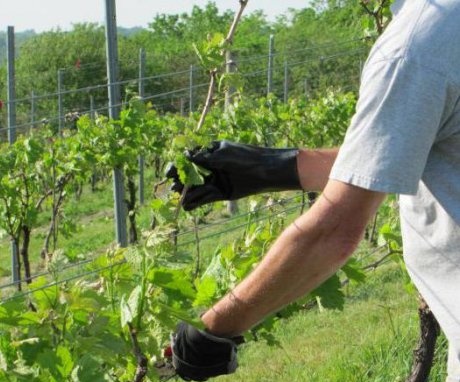
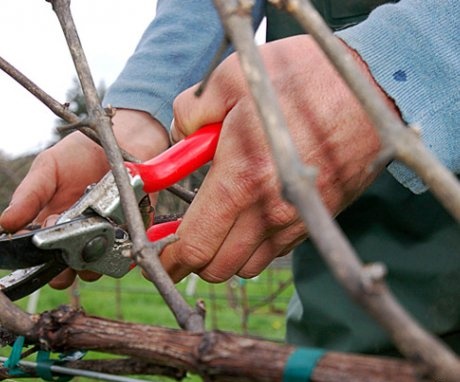
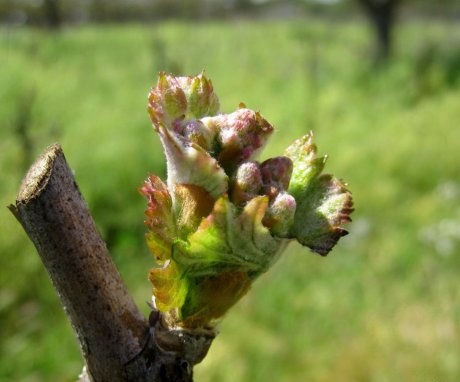
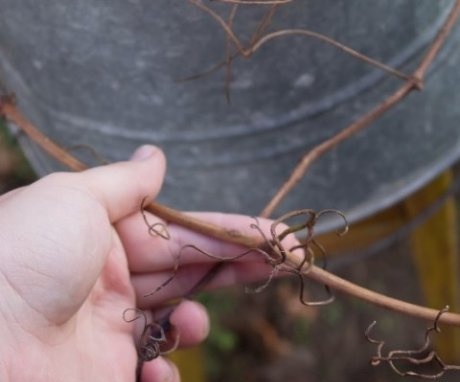
During pruning, you find a lot of underdeveloped and semi-dry shoots, so they should also be removed during pruning. Young grapes in the early years generally require special attention.